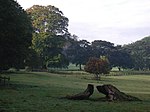The Battle of Towton took place on 29 March 1461 during the Wars of the Roses, near Towton in North Yorkshire, and "has the dubious distinction of being probably the largest and bloodiest battle on English soil". Fought for ten hours between an estimated 50,000 soldiers in a snowstorm on Palm Sunday, the Yorkist army achieved a decisive victory over their Lancastrian opponents. As a result, Edward IV deposed the Lancastrian Henry VI and secured the English throne.
Henry VI succeeded his father Henry V when he was nine months old in 1422, but was a weak, ineffectual and mentally unsound ruler, which encouraged the nobles to scheme for control over him. The situation deteriorated in the 1450s into a civil war between his Beaufort relatives and Queen Margaret of Anjou on one side, with those of his cousin Richard, Duke of York, on the other. In October 1460, Parliament passed the Act of Accord naming York as Henry's successor, but neither the queen nor her Lancastrian allies would accept the disinheritance of her son, Edward of Westminster, Prince of Wales. They raised a large army, who defeated and killed York and his second son Edmund at Wakefield in December. Financed by the City of London, York's son and heir, Edward, found enough backing to denounce Henry and declare himself king. The Battle of Towton was to affirm the victor's right through force of arms to rule over England.
On reaching the battlefield, the Yorkists found themselves heavily outnumbered, since part of their force under the Duke of Norfolk had yet to arrive. The Yorkist leader Lord Fauconberg turned the tables by ordering his archers to take advantage of the strong wind to outrange their enemies. The one-sided missile exchange, with Lancastrian arrows falling short of the Yorkist ranks, provoked the Lancastrians into abandoning their defensive positions. The ensuing hand-to-hand combat lasted hours, exhausting the combatants. The arrival of Norfolk's men reinvigorated the Yorkists and, encouraged by Edward, they routed their foes. Many Lancastrians were killed while fleeing; some trampled one another and others drowned in the rivers, which are said to have run red with blood for several days. Several high-ranking prisoners were also executed.
The strength of the House of Lancaster was severely reduced as a result of this battle. Henry fled the country and many of his most powerful followers were dead or in exile after the engagement, leaving a new king, Edward IV, to rule England. In 1929 the Towton Cross was erected on the battlefield to commemorate the event. Various archaeological remains and mass graves related to the battle have been found in the area centuries after the engagement.











